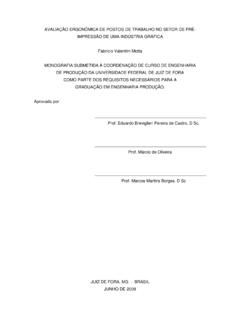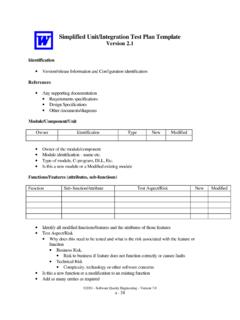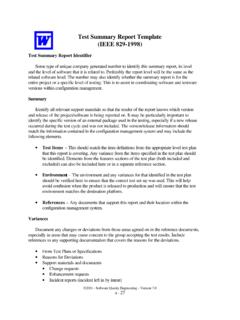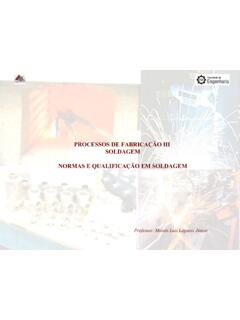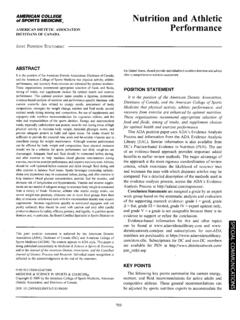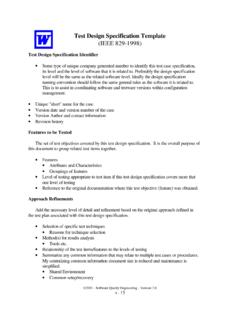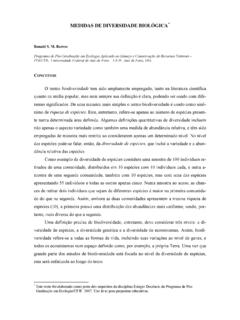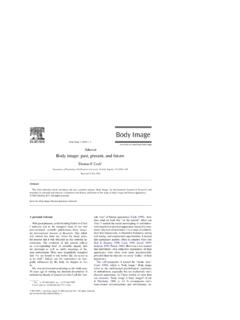Transcription of Using Hydrogen as Gas Turbine Fuel - UFJF
1 Paolo ChiesaGiovanni LozzaDipartimento di Energetica,Politecnico di Milano,Milano, ItalyLuigi MazzocchiCESI,Milano, ItalyUsing Hydrogen as Gas TurbineFuelThis paper addresses the possibility to burn Hydrogen in a large size, heavy-duty gasturbine designed to run on natural gas as a possible short-term measure to reduce green-house emissions of the power industry. The process used to produce Hydrogen is notdiscussed here: we mainly focus on the behavior of the gas Turbine by analyzing the mainoperational aspects related to switching from natural gas to Hydrogen .
2 We will considerthe effects of variations of volume flow rate and of thermophysical properties on thematching between Turbine and compressor and on the blade cooling of the hot rows of thegas Turbine . In the analysis we will take into account that those effects are largely em-phasized by the abundant dilution of the fuel by inert gases (steam or nitrogen), necessaryto control the N Oxemissions. Three strategies will be considered to adapt the originalmachine, designed to run on natural gas, to operate properly with diluted Hydrogen :variable guide vane (VGV) operations, increased pressure ratio, re-engineered performance analysis, carried out by a calculation method including a detailed modelof the cooled gas Turbine expansion, shows that moderate efficiency decays can be pre-dicted with elevated dilution rates (nitrogen is preferable to steam under this point ofview).
3 The combined cycle power output substantially increases if not controlled by VGVoperations. It represents an opportunity if some moderate re-design is accepted (turbineblade height modifications or high-pressure compressor stages addition).@DOI: #1 IntroductionHydrogen, as a carbon-free energy carrier, is likely to play aimportant role in a world with severe constraints on greenhousegas emissions. In the power industry, its utilization as gas turbinefuel can be proposed under several possible scenarios, dependingon the mode of H2production.
4 For instance, Hydrogen can beproduced remotely from renewable energy sources~solar or wind!or from nuclear energy~via direct thermal conversion or by elec-trolysis!, but in a more realistic and near-term vision it will bederived from conventional fossil fuels by conversion processesincluding CO2sequestration. Possible solutions include:~i!re-mote coal conversion to Hydrogen ~via gasification, shift, andseparation from CO2) and H2pipeline transport to the power sta-tion,~ii!integrated Hydrogen and electricity production from coalor natural gas, exporting pure Hydrogen to remote users, and usingon-site low-grade Hydrogen to produce power@1#,~iii!
5 Electricitygeneration from combined cycles integrated to fossil fuel decar-bonization~applicable to coal, oil, or gas!and to cells and H2-O2semiclosed cycles may represent future op-tions for power generation, but combined cycles coupled to H2production/CO2sequestration processes can be proposed as ashort/mid-term solution for massive greenhouse gas emission paper addresses the possibility to burn Hydrogen in a largesize, heavy-duty gas Turbine designed to run on natural gas, for aprompt application of the above general concepts.
6 Regardless ofthe process used to produce Hydrogen and its integrations with thecombined cycle. We will focus on the behavior of the gas Turbine ,by considering the effects of the variation of volume flow ratesand of thermophysical properties, related to switching from natu-ral gas to Hydrogen . These effects are emphasized by the fact thatNOxemission control relies on fuel dilution with large quantitiesof inert gases, like steam or nitrogen, as discussed in Sec. 2. Theconsequent variation of the operating conditions is therefore muchlarger than for the mere fuel substitution, calling for an analysis ofthe opportunity~or necessity!
7 Of design modifications to the gasturbine. The paper discusses these issues by considering somepossible adaptation techniques, by discussing their operationallimits and, mostly, by predicting the resulting combined cycleefficiency and power speaking, three methods have been used to reduceNOxemissions from gas Turbine power plants:~i!premixed com-bustion, including catalytic combustion,~ii! fuel dilution, mostlyby steam, water or nitrogen;~iii!removal from exhaust gases. Fornatural gas applications, the first technique is the preferred one: atpresent, the dry low-emission combustors are proposed bymanufacturers for virtually any gas Turbine model.
8 Their basicprinciple is to achieve a moderate flame temperature by forcingmore air than stoichiometric in the primary zone; this is obtainedby mixing air to fuel before the combustion. Catalytic combustors,often referenced as the future technology for extremely low emis-sions, just enhance the same principle, allowing for a much largerrate of premixing, no longer limited by flame stability switching to Hydrogen ~or to hydrogenated fuels, such asthe coal syngas used in IGCC plants!premixing becomes a veryquestionable practice, due to the much larger flammability limitsand the lower ignition temperatures of Hydrogen with respect tonatural Therefore both dry low-emission and catalyticcombustors cannot be safely proposed for large industrial applica-tions, to the authors knowledge, simply because hydrogenpromptly reacts when mixed to air at typical gas Turbine condi-tions, at virtually any rate.
9 In fact, IGCC combustors, handling aCO-H2mixture with H2content from 25 to 40%, are diffusionburners and pre-mixed combustion was never attempted. Massivesteam or nitrogen dilution is extensively used in these combustors@4#to control NOx. In diffusion burners, the stoichiometric flametemperature~SFT!is representative of the actual flame tempera-ture, strictly related to the NO formation 1 shows a collection of literature data, mostly retrievedfrom a GE experimental investigation with hydrogenated fuelsContributed by the International Gas Turbine Institute~IGTI!
10 Of THEAMERICANSOCIETY OFMECHANICALENGINEERSfor publication in the ASME JOURNAL OFENGINEERING FORGASTURBINES ANDPOWER. Paper presented at the Interna-tional Gas Turbine and Aeroengine Congress and Exhibition, Atlanta, GA, June16 19, 2003, Paper No. 2003-GT-38205. Manuscript received by IGTI October2002; final revision March 2003. Associate Editor: H. R. of Engineering for Gas Turbines and PowerJANUARY 2005, Vol. 127 73 Copyright 2005 by ASME reported by Todd and Battista@5#, showing a relation betweenSFT and NOxemission for various fuels in typical gas turbineconditions.
